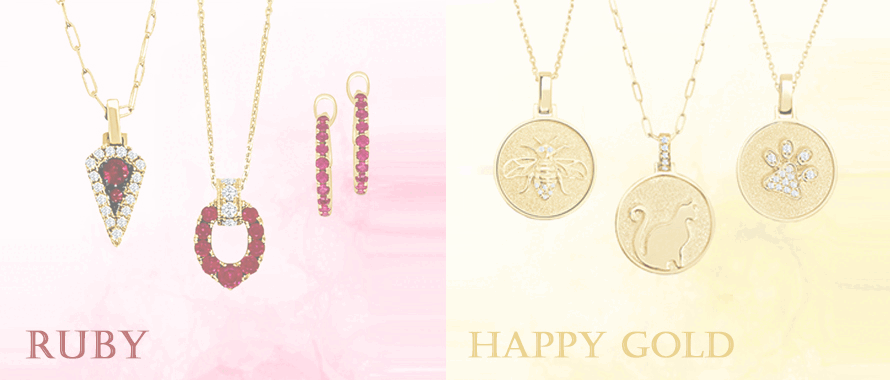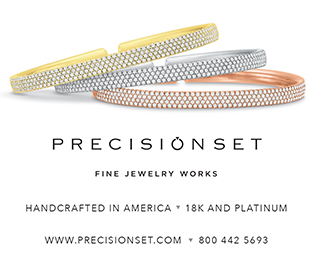Articles and News
Leslie McGwire: A Few Things to Consider When Conceptualizing Jewelry Store Layout Designs | February 27, 2024 (0 comments)

West Bloomfield, MI--In a perfect world, businesses would be able to take customers by the hand and show them different jewelry around their retail spaces. These customers would see everything that the businesses wanted to show them, in the order in which they were best seen.
Each of these customers would feel right at home and having had an outstanding shopping experience, would love to come again. Such personalized guidance is not always possible in the real world, particularly for large jewelry stores with many store spaces visited by many customers a day. A carefully layout design crafted, however, can guide customers around a store and provide an enjoyable experience that encourages a connection between those customers and the business. That connection has the potential to become stronger with every visit to that jewelry store space. The stronger the relationship connection, the greater the potential for sales growth and customer loyalty. Be sure to consider the following components of jewelry store layout designs before planning a new space or remodeling out an existing one.
The Target Customer
Jewelry store layout design should be part of the comprehensive marketing and sales plan of a business. That plan should never be formulated without a thorough understanding of the target customer, who are necessarily the same customers of the jewelry store. With the broader characteristics of the target customer such as demographics and points having been covered in the comprehensive plan, design layout must place particular emphasis on characteristics related to buying behavior.
The customers displaying these characteristics may be classified loosely as follows:
- Savings customers tend to make small rather than bulk or major jewelry purchases, or upgrade rather than buy a new unit, and are usually on the lookout for discounts.
- Savvy customers prefer to compare jewelry items before buying and may not necessarily make a purchase during a visit to the store but are there to study the jewelry offerings.
- Social customers tend to take their time in the store and move around at a more leisurely pace with the jewelry of exploring and taking photos for social media.
- Speedy customers know exactly what they want upon entering the store and tend to go straight to the jewelry they want, and from there to checkout.
Armed with this knowledge, businesses will be better able to create a “personalized” jewelry store layout design that is more effective in meeting the needs of the target customers. Suggestions for tailoring the store layout to appeal to these groups include:
- Grouping related jewelry items and highlighting promos for savings customers.
- Placing easy-to-read product descriptions and spotlighting jewelry items demo areas for savvy customers.
- Creating a jewelry store layout design that encourages exploration and selfies as well as incorporates in-store event areas for social customers.
- Placing essential jewelry items near checkout or the exits and using displays that take up less floor space for speed customers.
Traffic Flow and Pathways
It makes perfect sense to make it easy for customers to move around the store, and a good jewelry store layout design will include clear pathways and other elements that facilitate navigation. Even large jewelry store spaces can quickly become cluttered by displays and other visual merchandising materials, which can quickly be compounded by a large influx of customers. A planned jewelry store lay out may be described as bird’s eye view maps of a retail space with the sole objective of optimizing sales. A good jewelry store interior designer will build on a basic layout by using it to map and direct traffic flow while keeping comfort and ease for the customer in mind.
_Baxters_Jewelry_-_POS__Cases_005.jpeg)
[Baxter's Fin Jewelry POS and cases. Photo credit: Leslie McGwire]
The jewelry store interior designers must leave ample space or make provisions for high traffic areas such as displays for new jewelry items/products or promotional items, and potential bottlenecks such as the area’s leading to checkout (See picture above of Baxter’s Fine Jewelry for example of ample space for high traffic). Jewelry store interior designers must also take care to avoid the formation of dead ends to save customers from having to double back and from cutting off their view of the rest of the store. While it also makes sense to place high-demand products well within a customer’s field of view, these jewelry items can also be positioned in other strategic ways. Placing new or related items close to those in high demand may influence customers to purchase or to at least learn more about them. These related items may also be positioned along the path leading to high-demand products for the same reason.
Store Layout Zones
The jewelry store may also divide the retail space into zones, beginning with the entrance area or decompression zone. This zone allows customers to adjust from being on the sidewalk or in the rest of the mall, to being in the enclosed, controlled environment of a brand. Decompression zones generally extend about eight feet to ten feet from the entrance into the store. It is advisable to keep the zone decluttered, not only to facilitate the adjustment but to allow customers to see all around the retail space upon entry.
While zones vary between jewelry store spaces in different store space available as well as the total size of the space, zones found in most store layout designs include:
- High-demand zones for popular jewelry.
- High-traffic zones leading to popular jewelry.
- Low-demand or steady zones for less popular jewelry.
- Seasonal zones for rotated or event-related jewelry lines.
- Waiting zones and rest zones for customers waiting for jewelry or resting.
- Impulse zones for last-minute purchases of jewelry.
Popular zoning strategies include guiding customers through low-demand and steady zones enroute to high-demand or seasonal zones. Seasonal zones often have pride of place in jewelry store layout designs to engage customers on sight. Waiting and rest zones should be placed so as not to impede the overall traffic flow and designed to make the wait and the pause as pleasant as possible. (See picture below of Baxter’s Fine Jewelry very comfortable waiting area with fireplace, TV and a high-end coffee House called THE FIFTH C). A customer might be waiting for gift-wrapping, for instance, or taking a break after walking through a larger store. While ample space and reasonably comfortable seats are standard inclusions in this zone, some jewelry store spaces include displays or other promotional materials for customers to look at while waiting.
_Baxters_Jewelry_-_Louge_Coffee__Area_001.jpeg)
[Baxter’s Fine Jewelry waiting area with fireplace, TV and coffee house. Photo credit: Leslie McGwire]
POS Areas
The POS area marks the last stop on a customer’s visit to a store, and a good retail store layout design will make the most of this last chance to encourage or increase a purchase. Apart from placing impulse zones near or at checkout, recommendations for optimizing checkout zones include:
Adjusting the size of your POS to the size and type of your retail space. Smaller stores might have POP displays in their checkout zones, while larger stores might separate the checkout from the cash wrap which they position at the back or middle of the store.
Making sure your POS is well-lit and well-designed to make a good last impression on customers leaving the store.
Encouraging last-minute purchases by stimulating the senses with aromatic or tasty product samples at the POS.
Making sure there is enough space for other customers by incorporating ways to reduce physical contact between staff and customers at checkout such as digital POS solutions is still a good idea.
_Baxters_Jewelry_-_Lay-Out__Cases_with_POS_006.jpeg)
[Baxter’s Fine Jewelry layout design with well-lit POS. Photo credit: Leslie McGwire]
A carefully designed layout design, however, can guide customers around a store and provide an enjoyable experience that encourages a connection between those customers and the business (See Picture above of Baxter’s Fine Jewelry as a great example of a well-crafted layout design with well-lit POS). A few essential things to consider when conceptualizing jewelry store layout designs: The Target Customer, Traffic Flow and Pathways, Store Layout Zones, and POS Areas. That connection has the potential to become stronger with every visit to that jewelry store space. The stronger the relationship connection, the greater the potential for sales growth and customer loyalty. Be sure to consider the following components of jewelry store layout designs before planning a new space or refitting out an existing one.
About the Author: Leslie McGwire™ has over 35 years in business development, interior design and marketing services in retail and jewelry-based businesses. Leslie has won 25 national design awards, including the prestigious Salon Today and INSTORE Jewelry Store awards. Leslie has a true passion for business, design in the retail and jewelry industries. Visit lesliemcgwire.com for more information.







